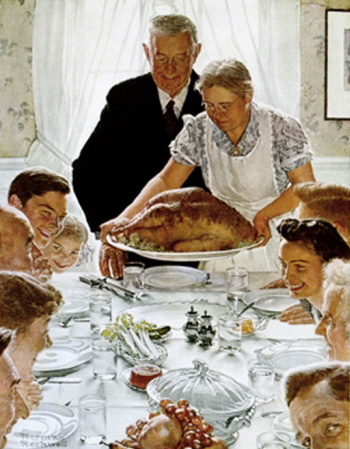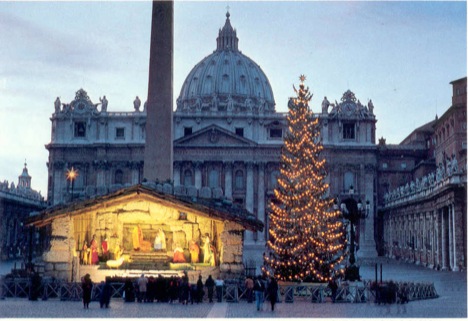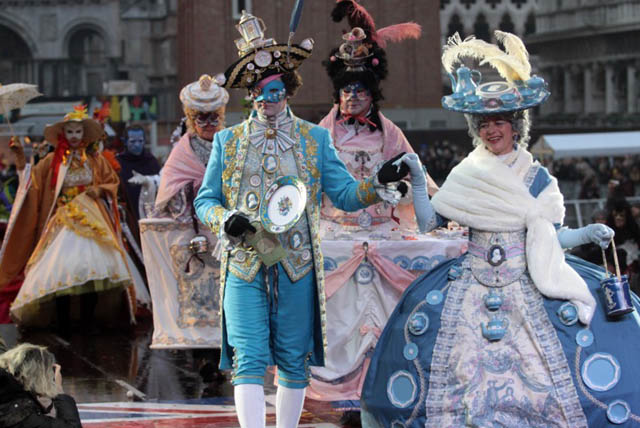
Che settimana impegnata! Durante questi ultimi sette giorni c’era così tanto in corso che non so nemmeno da dove cominciare! Il sabato scorso (15 febbraio) il Carnevale a Venezia è stato lanciato, con tanta allegria e una sfilata di barche lungo il grande canale. Questa settimana Sanremo, il festival annuale di musica, è anche iniziato al teatro Ariston con i maestri di cerimonia già ben conosciuti Luciana Lettizetta e Fabio Fazio. Oltre a tutto questo, le Olimpiadi di Sochi sono ancora in corso in Russia, nonostante gli sconvolgimenti in Ucraina.
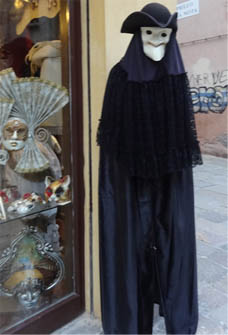
Studentessa Matta
What a busy week! During the past seven days, there has been so much going on that I don’t even know where to begin. Last Saturday (February 15th) Carnival was launched in Venice with a parade of boats down the grand canale. This week Sanremo, Italy’s annual music festival also got underway in the Ariston Teatro with returning hosts, Luciana Lettizetta and Fabio Fazio. In addition to all that the Sochi Olympics are still powering on in Russia, despite the upheavals in Ukraine.
Mentre mi piace lo sfarzo del Carnevale, so che ad alcuni locali, il Carnevale sta perdendo un po’ del suo fascino ed è visto più come un fastidio che altro. I veri veneziani pensano che ora sia più una festa per i turisti. Preferiscono invece, altri festival che mantengono un’autenticità pura, come le feste meno note come quella della Salute, a novembre o il Festival del Redentore, a luglio. Il festival del Redentore commemora la fine della peste del 1576 quando la città ha chiesto a Palladio di costruire una chiesa sulla isola della Giudecca. Per festeggiare, invece di indossare maschere, i veneziani costruiscono un ponte di barche che attraversa il canale e le barche di ogni forma e dimensioni si riuniscono nella laguna tra s. Marco e la Giudecca. Ogni barca è piena di festaioli che portano con loro uno spuntino e vino. La festa culmina in un incredibile spettacolo pirotecnico.
Now while I like the pageantry of Carnival, I know for some locals, Carnival in Venice is losing some of its charms and is seen more as an annoyance than anything else. True Venetians feel that nowadays it is mainly a tourist attraction. They prefer instead festivals that retain a purer authenticity, such as the lesser-known Festa della Salute in November, or the Festival del Redentore in July. The Festival del Redentore commemorates the end of the plague In 1576 when the city commissioned Palladio to build a church on the Guidecca. To celebrate, instead of donning masks, the Venetians build a pontoon bridge across the canal, and boats of every shape and size gather in the lagoon between S Marco’s and the Giudecca. Each is filled with merrymakers carrying with their picnics and wine. The party culminates in an amazing fireworks display.
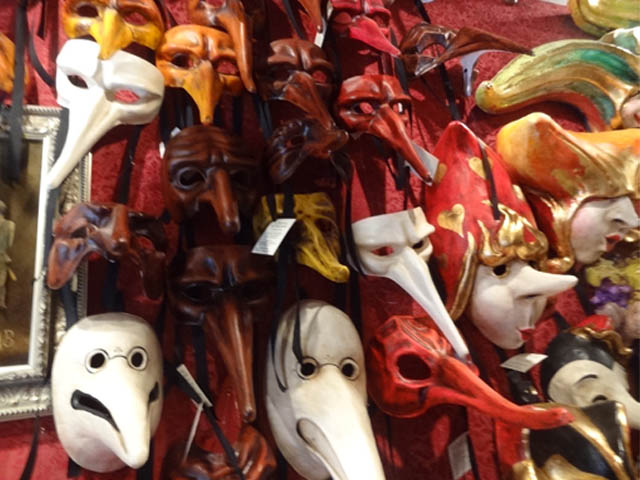
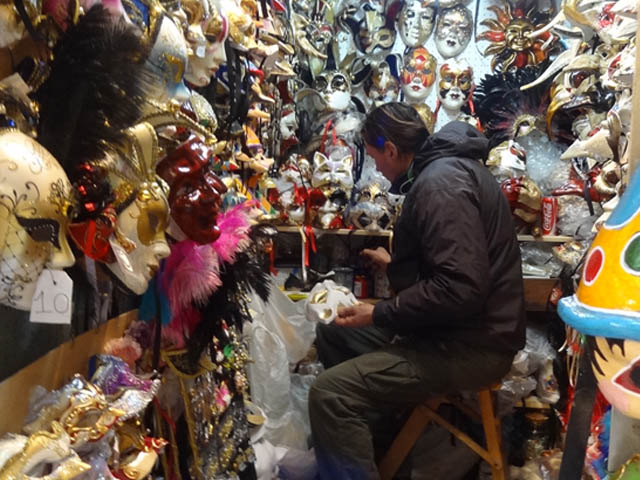
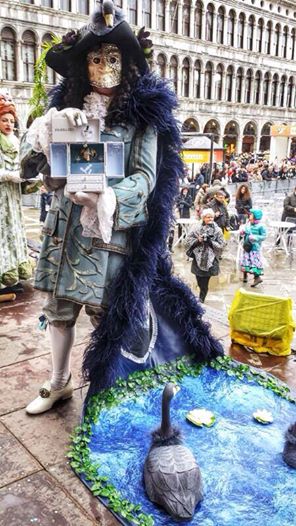
Poichè io non devo sopportare la folla anno dopo anno come i veneziani devono fare, posso tranquillamente dire che adoro il fasto e lo splendore del Carnevale. Mi piacciono i costumi d’epoca, i colori vivaci, le decorazioni sontuose e creative e naturalmente le maschere. Ogni maschera è come un piccolo opera dell’arte, con una storia da raccontare. Alcune di quelle più note, sono ispirate su personaggi Colombina, Pantalone e Arlecchino dalla “commedia dell’arte”, un tipo di teatro iniziato nel 16˚ secolo. Un’altra maschera popolare è la maschera bianca chiamata “bauta” che è molto inquietante a causa del naso prominente e la linea del mento. Nello stesso vena di maschere sconvolgente sono quelli strani del Dottore. È dotato di un lungo naso, come il becco di un uccello. Nel medioevo i medici avevano messo erbe nella cavità nasale per proteggersi dai pazienti con la peste. Interessante no? (Guardate un piccolo spettacolo con una maschera). Ogni anno c’è anche il concorso della maschera più bella. Quest’anno uno dei primi vincitori è stato “il duca del laghetto delle anatre!”
I guess because I don’t have to put up with the crowds year after year, as the Venetians do, I can safely say that I adore the pomp and splendor of Carnival. I like the period costumes, the lively colors, the lavish and creative decorations, and of course the masks. Each one is like a mini piece of art with a story to tell. Some of the best-known ones are based on the characters Colombina, Pantalone & Arlecchino from “la commedia dell’arte”, a type of theater that begun in the 16th century. Another popular mask is the stark white “Bauta” mask, which is very disturbing because of its over-prominent nose and projecting chin line. In the same vein of disturbing masks is that of the Doctor. It features a long bird-like beak and during the middles ages, physicians placed herbs in the nasal cavity to protect themselves from plague-infested patients. Interesting no? (Watch a little show with with masks). Every year there is also the competition of the best mask. This year one of the first winners was “the duke of the duck pond!”
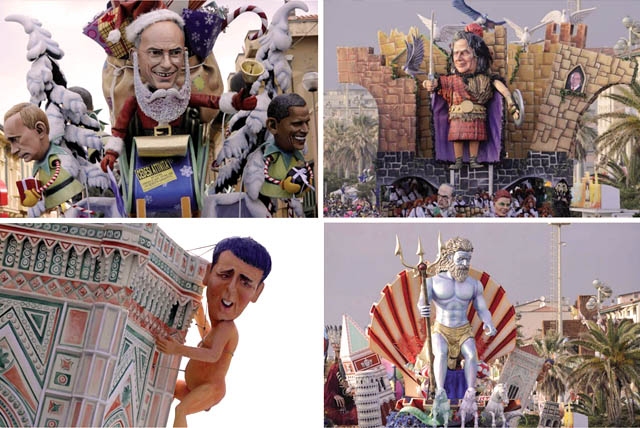
Trovo anche intriganti i carri allegorici che vedrete in altre città d’Italia, come Viareggio, Cento e Puntignano. Ogni anno artisti di cartapesta costruiscono carri fantastici con raffigurazioni enormi per prendere in giro i politici e per raccontare gli scandali correnti. Quest’anno le immagini erano particolarmente interessanti. Includo alcune foto che ho trovato sul sito di Italy Magazine per voi.
I also find intriguing the carnival floats that you will see in other cities in Italy, such as Viareggio, Cento & Puntignano. Each year cartapesta artists create fantastic floats and huge figurines that poke fun at political leaders and current scandals. This year’s images have been especially delightful. I include a few photos that I found on the Italy Magazine site for your viewing pleasure.

Attenzione! Prima che Carnevale si potesse concludere, ci deve essere il volo dell’angelo! Il volo quest’anno si svolgerà il 23 febbraio. Julia Nasi, la vincitrice del concorso di bellezza – la Festa delle Marie – sarà la ragazza che volerà dalla cima del campanile in piazza S. Marco alla piazza più in basso. Il volo dell’angelo ha le sue radici nella metà del 16˚ secolo, quando un acrobata turco ha fatto qualcosa che stupì i veneziani. Con solo un palo camminava su una corda da una barca legata nel canale alla cima del campanile. È diventato una bravata popolare che è stata ricreata per anni dopo, fino a quando uno sfortunato acrobata ha caduto alla sua morte. Dopo quello è stato vietato utilizzare essere umani e così hanno sostituito pupazzi. Ma più recente con l’avvento di una corda tesa e fili guida i veneziani ritengono che la bravata è sicura di nuovo. Buon volo, Julia! Sono sicura che tutto andrà benissimo quest’anno. Guardate un piccolo clip di Julia mentre lei prepara per il volo.
Hold on to your seats, because before Carnival concludes, there must be the Flight of the Angel! This year’s flight will take place on Sunday, February 23. Julia Nasi, the winner of the beauty competition – la festa delle Marie will be the lucky gal who will fly from the top of the Bell Tower in piazza s. Marco to the piazza below. The Flight of the Angel has its roots in the mid-16th century when a Turkish acrobat did something that stupefied the Venetians. With only a pole he walked on a rope from the boat tied in in the canal to the top of S. Marks Tower. It became a popular stunt that was recreated for years until one unfortunate acrobat fell to his death. After that, it was forbidden to use real people and so dummy bodies were used instead. But more recently with the advent of zip lines and guide wires, the Venetians feel that the stunt is safe to perform again. Happy flying Julia! I’m sure you will do just fine this year! Watch a little clip as Julia prepares for her flight
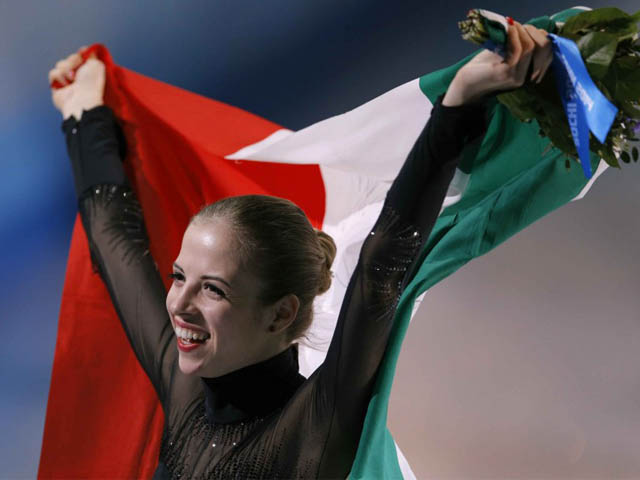
A parte di Carnevale, questa settimana ho anche tenuto un occhio su Sanremo e l’altro sulle Olimpiadi invernali di Sochi. Scrivo in un altro post delle buffonate di Luciana Littizzeto ed altre notizie di Sanremo, ma vorrei dirvi che Carolina Kostner, la pattinatrice italiana, ha preso la medaglia di bronzo nella competizione di pattinaggio artistico a Sochi questa settimana. Dopo il suo programma libero, con la musica del “Bolero” Kostner ha guadagnato il suo miglior risultato della sua stagione con una medaglia di bronzo. Lei è il primo italiano a vincere una medaglia olimpica di pattinaggio per un solo esecutore. Brava Carolina! Non hai bisogno di una “zip line” per essere un angelo in volo…basta una lastra di ghiaccio! Complimenti!
In addition to Carnival, I have also been keeping one eye on Sanremo and the other on the winter Olympics in Sochi. I will save the antics of Luciana Littizzetto and other Sanremo news for another post, but I would like to mention that the Italian figure skater Carolina Kostner took the bronze medal in artistic figure skating in Sochi this week. After her free skate to “Bolero,” Kostner earned the best score of her season, along with a bronze medal. She is the first Italian ever to win an Olympic figure skating singles medal. Brava Carolina! You don’t need a zip line to be a flying angel…you just need a sheet of ice! Well done!
